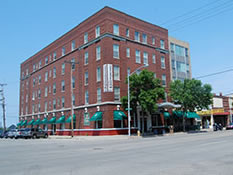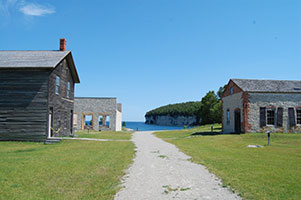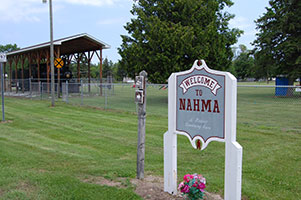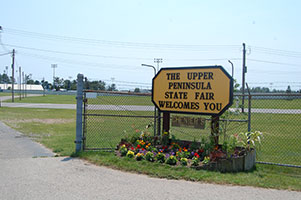Click on the sites below and explore Delta County!
Explore Delta County
Carnegie Public Library
The Carnegie Public Library in Escanaba was built in 1902 in the Neo-Cassical style. It was designed by Escanaba architect Theodore Lohff and constructed with money from a grant given by Andrew Carnegie, Pittsburgh steel baron. The library opened in 1903 and served the community for a number of years. Some changes have occurred to the building since its construction, and in 1995, the city sold the building to the Neumeiers. They are renovating the building and converting it into a private residence. Though it is no longer in use as a library, the building is only one of around 242 buildings to remain out of a total of 2,500 buildings worldwide which were financed by Carnegie.
Additional Information
- The Carnegie Public Library is located at 201 South 7th Street in Escanaba, Michigan.
- The owner stated in a newspaper article in 2008 that when renovations were completed he may open the building as part of a parade of homes event, and if someone were to ask him before then, he may be inclined to provide a tour.
Learn More

Delta Hotel
The Delta Hotel opened in January, 1914, at the height of Escanaba's iron ore mining and exporting boom. It is a five story brick, Neoclassical style building which was financed by local businesspeople through an area stockholders' corporation. Prior to its construction, the population of Escanaba jumped from 9,500 to 14,500 between 1900 and 1913. So, extra living space was needed in the town. The hotel stayed Escanaba's preeminent hotel over the next several decades and stood as a symbol of the city's progress. After the mining slowed in Escanaba, the hotel was sold to the Catholic Church, who used it as a home for older people in the community. It was since sold again and houses shops on the first floor and apartments on the upper floors.
Additional Information
- The Delta Hotel is located at 624 Ludington St. in Escanaba, Michigan.
- The hotel can be visited any time during the year.
Learn More

Fayette Historic Townsite
Historic Fayette is all that remains of the original boom town. The Jackson Iron Company founded the town in 1867 because of the limestone and large amount of hardwood trees. These two items are what the Jackson Iron Company needed to extract iron, through the smelting process, from the ore which was being mined near Negaunee, Michigan. The town grew up around two blast furnaces, a large dock, and several charcoal kilns after the Civil War. Nearly 500 residents, many of who immigrated from Canada, the United Kingdom, and northern Europe, lived in and around the town. The town thrived until 1891, when the hardwood near the town was gone. The Jackson Iron Company found it no longer profitable to run Fayette and the once boom town slowly became deserted. During its 24 years of operation, Fayette's blast furnaces produced a total of 229,288 tons of iron.Fayette is now a Michigan State Park and around twenty of the buildings have so far been restored. Visitors are able to explore the town and learn about life in Fayette during the late 19th century.
Additional Information
- Fayette is located off of US 2, south on Delta County Road 183 for 16 miles.
- Fayette is open daily from mid-May to mid-October. Michigan State Park Permit required, otherwise must pay admission.
Learn More
- Visit the Fayette Historic Townsite website.
- View on Google Maps
House of Ludington
The Gaynor House hotel was built primarily of wood in 1864 by E. Gaynor. Later, in 1871, he renamed the hotel to the Ludington House after lumberman Nelson Ludington. In 1883, proprietor John Christie purchased the hotel, tore it down and re-built it as a brick building. He renamed the hotel, the New Ludington Hotel. From this change, the hotel shows Queen Anne resort architecture, which was popular in the 1880s and 1890s. Later, the west wing was added and around 1910, the east wing was added. This expanded the building to 100 rooms. In 1939, the hotel was purchased by Pat Hayes. Throughout the years, Pat made many renovations to the hotel, the most noticeable being the external glass walled elevator which was installed in 1959. In the fall of 1982, the hotel underwent extensive remodels and was redecorated by owners Gerald and Vernice Lancour before being closed again in 1996. It was then purchased by Edward and Suzell Eisenberger along with their two children, who reopened the hotel in 1998.
Additional Information
- The House of Ludington is located at 223 Ludington Street in Escanaba, Michigan.
Learn More
- Visit the House of Ludington Hotel & Restaurant website.
- View on Google Maps
Maple Ridge Workers Assocation Hall
The Rock Maple Ridge Workers Association was a branch of the Socialist Party, which may have started out in Marquette County as early as 1908 and in Squaw Creek in 1911. These two groups most likely formed the main members of the Maple Ridge Workers Association of the township in 1912 when it became active. This group built the Maple Ridge Workers Association Hall, also known as Rock Finn Hall, in 1914. The Hall is a long, two-story, side-gable building which, in 1931, had to replace the cedar log foundation because it was deteriorating, and replaced it with concrete. Originally, the building was used as a social, intellectual, and recreational center for Finnish members of the surrounding communities. Now the building is in use as a craft store and curio museum and houses public events.
Additional Information
- The Maple Ridge Workers Association Hall is located on County Road 529 at M-35 in Rock, Michigan.
- The Hall is open all year.
Learn More
- Visit the Rock Maple Ridge Workers Association records website.
- View on Google Maps

Nahma, Michigan
The town of Nahma was first established as early as 1856, when it gained its first post office, though a water powered saw mill was built in 1848, which was probably about the time people Americans began living in this area. There was a County Road built through Nahma in 1868 and the next year the Mackinac State Highway was built through the township.The Bay de Nocquet Lumber Company was founded in 1881, and the mill started sawing in 1882. The Company at one time owned 200,000 acres of land and during its heyday employed 1200 men. During this time, Nahma had a club house for basketball , bowling, a social gathering area, a sweets shop, barber shop, library, bar, lounges and many other amenities for the residents of the town and visitors. The Company also had a golf course, public beach, tennis courts, baseball fields, and many hunting opportunities on their land. The Company closed in 1951 due to lack of timber resources in the area. For a few years before that, they had been selling their land to the US Forest Service for inclusion in the Hiawatha National Forest, as well as many other buyers. When the Company closed, the town went up for sale and was advertised in Life Magazine at a price of $250,000.The town was purchased that same year by American Playground with the intent of moving their company from Indiana to Nahma, but only a portion of the plant was ever moved and it closed in 1987. During this time, American Playground continued to sell the land to the government and private buyers. It was sold again in 1988 and there was an attempt to create a resort town out of Nahma, but that ended in 1992 and the owner again began selling off pieces of land. Today, very few of the original company buildings remain, due to fire and neglect, but there are still some buildings in existence as well as the No-Nahma Resort and the old Locomotive No. 5, which ran from 1922 through 1948, serving 15 lumber camps on 75 miles of track.
Additional Information
- To visit Nahma, from US-2, take GG Road right into the town.
- The town can be visited all year round, but it would be best walking conditions to visit in the summer months. There is a museum in Nahma which is open during the summer on Saturdays and Sundays from 1-4 pm.
Learn More
- Visit the Nahma Township website.
- View on Google Maps
Peninsula Point Light Station
Peninsula Point Light Station was built in 1865 after almost ten years of negotiation with the U.S. government for the necessary funds. When completed, Peninsula Point consisted of a rectangular one and a half story house with seven rooms and a square tower built into the center of the southern end. The square light station tower had a circular interior which housed the cast iron spiral stairs which led to the lantern floor. The light station was equipped with a Fourth Order Fresnel lens which sat at 41 feet above lake level and was visible 12 miles under clear conditions. In 1893, an unpowered lightship, LV60, was anchored on Eleven-Foot Shoal just off the coast of the Peninsula Point Light Station. This lightship could be seen 13.5 miles under clear conditions. The stationing of this unpowered lightship, Peninsula Point was supposed to be considered unnecessary, but the station continued to remain active in helping with navigation. So Peninsula Point continued and in the next five years improvements were made to the living quarters. In 1913, the kerosene-fueled within the Fresnel lens was upgraded to a system fueled by coal gas. This increased the candlepower from 520 to 2,000. In 1922, the Fourth order lens was replaced with an automated 300mm lens equipped with a 300-candlepower acetylene flasher and sun valve. This automation made need for a light Keeper unnecessary, though, the Keeper at the time stayed on for another three years, when he accepted a transfer to Escanaba. In 1925, LV60 no longer served its purpose of marking the shoal effectively, and was decommissioned and sold. In 1936, Peninsula Point was decommissioned as well due to changes in shipping. In 1959, the Keepers dwelling burned beyond repair, so the Forest Service cleared the remains and repaired the tower in 1962. The light station is now a part of Hiawatha National Forest, and the tower is maintained. Visitors are free to climb the spiral staircase to the top of the tower and enjoy the view.
Additional Information
- The Light Station is located off of US-2, exit towards Stonington and follow County Road 513 to the tip of the peninsula.
- The Light Station is open all year round, though it would be best to go during the spring, summer, and fall months.
Learn More
- Visit the Forest Service Peninsula Point Lighthouse website.
- View on Google Maps
Sand Point Lighthouse and Delta County Historic Society
The Sand Point Lighthouse was constructed by the National Lighthouse Service in 1867. It was a story and a half, rectangular building connected to a brick tower which was topped with a lantern room. The lantern room housed a fourth order Fresnel lens, which was first shown on May 13, 1868. The light warned the many steamers, whalebacks, and passenger ships that were carrying ore, lumber, and travelers from Escanaba of Sand Point and the sand reef that reached out into the Bay. The Sand Point Lighthouse served mariners continuously from its construction in 1868 until 1939, though in 1886 it was being repaired because of a fire that severely damaged the building. In 1939, the Coast Guard took over the Lighthouse and built a crib light several hundred feet off shore because the dredging and filling of Escanaba Harbor left the light a distance away from the hazard of the point and sand reef. The Lighthouse was altered to become the family residence of the Officer in Charge of the station. The lens and lantern were removed and major renovations done to the original building in order to make it a home. In 1985 the Coast Guard decided to discontinue the use of the building and destroy it. The Delta County Historical Society negotiated a lease from the Coast Guard, and they began fundraising to restore the Lighthouse in 1986. The Lighthouse and Museum was opened to the public in 1990.
Additional Information
- The Lighthouse and Museum are located at 16 Water Plant Road, Escanaba, Michigan.
- The Sand Point Lighthouse and Museum are open for tours during the summer months from Memorial Day through Labor Day, 11am – 4pm.
Learn More
- Visit the Sand Point Lighthouse website.
- View on Google Maps
St. Martin Island Light Station
The St. Martin Island Light Station was built in 1905, though the United States Lighthouse Board had requested funds to build the Light Station in 1891. It was about this time that the shipping industry out of Escanaba was growing and the station was needed because of St. Martin Island and the dangerous reefs that surrounded it. The Light Station is hexagonal in shape, and is supported by six exterior steel posts. It is the only exoskeletal Light Station on the Great Lakes. On the top of the 57 foot white tower is the eight foot watchroom which houses a Fourth Order Fresnel Lens, manufactured by Barbier, Benard and Turenne of Paris. The station also includes a two-story keepers dwelling and a fog signal building. The St. Martin Island Light Station is no longer in operation. The Fresnel lens has been removed and can be viewed at the Point Iriquois Light Station in Chippewa County.
Additional Information
- This Light Station or island are not open to visitors, but can be seen in passing the Island on a boat. The Fourth Order Fresnel lens can be viewed though, and that is worth a visit if one has never seen one.
Learn More
- Visit the St. Martin Island Lighthouse website.
- View on Google Maps

U.P. State Fairgrounds and Heritage Center
In 1927, Fred Green, then Governor of Michigan, signed into law the state fair held in Escanaba to support and promote improvements in agriculture and industry. The original grounds contained livestock barns, exhibition buildings and a grandstand for horse racing. Today, the grounds span 120 acres and have seen improvements to the equestrian facilities, grandstands, and other auxiliary buildings. The fair is held annually in August, along with the opening of the Heritage Village, or U.P. Steam and Gas Engine Village and Museum. The Village offers visitors an interactive learning experience. Local artisans provide demonstrations of traditional handicrafts like glassblowing, knitting, spinning, weaving, quilting, pottery, and woodcarving. The Village also features small shops like an old time village, such as a blacksmith shop, cook shack, and ice cream parlor.
Additional Information
- The Fairgrounds and Heritage Village are located in Escanaba, take 12 Avenue North off of M-35.
- The Fairgrounds are open in August, for the annual fair. The Heritage Village is open at this time as well as in September for their Annual Show and for Christmas.
Learn More
- Visit the U.P. State Fair website.
- Visit the U.P Steam & Gas Engine Association website.
- View on Google Maps
